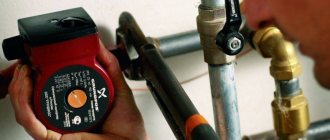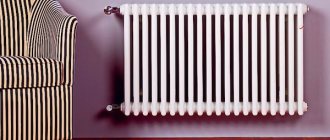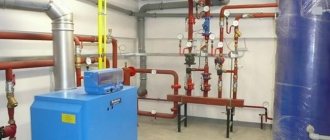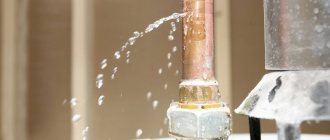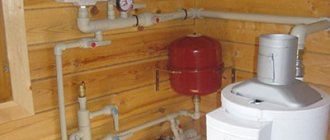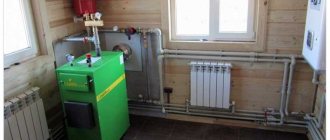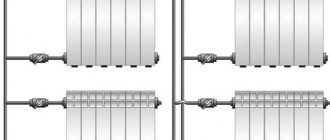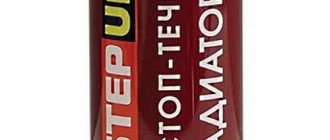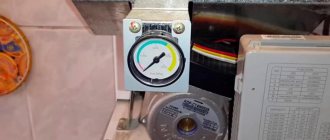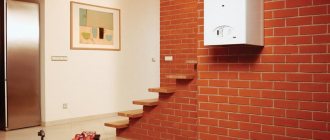What to do if the radiators in the apartment are cold and the riser is hot?
Regardless of whether the cold heating equipment is only in the riser or in the entire entrance, and possibly throughout the house, you must seek help from qualified specialists.
In the case of an apartment building, this is a plumber of the company that is responsible for the heating supply of the house. Cold batteries with a hot riser may be due to a clogged system or the formation of an air lock in it. An important factor is the pressure in the wiring. In some cases, the problem of low coolant flow is relevant. It is possible to independently find out the reason for the low efficiency of heating elements. But only a true professional in his field will clearly answer any questions that arise and competently fix the breakdown. This video will help you to make your radiators heat better:
Often, residents of both apartment buildings and private houses are faced with the problem of cold radiators. In this article we will explain why this problem occurs and what to do if the batteries are cold.
What are the consequences of inefficient operation of heating devices?
The problem of uneven heat distribution in a heating radiator cannot be solved by itself. If you do not pay attention to it, it is fraught with the following consequences:
- The efficiency of heating equipment decreases;
- The apartment becomes cold;
- The risk of a pipe burst increases;
- Economic losses. If in an apartment building the heat meter is common to the building, then the cost of services will be divided among all heat consumers, although the heat output will be low.
- There is a possibility of freezing the heating system. This possibility is unlikely, but such cases occur periodically.
If the air temperature in the room does not meet established standards, then residents will be forced to pay utility bills not for the supplied heat, but for the cold air.
In addition, people connect electric heating devices, which entails increased energy costs. Optimal room temperatures:
- living room and bedroom - from + 18 to + 22°C;
- toilet - + 18°C;
- bathroom - from + 20 to + 25°C;
- corner room - from + 20 to + 24°C.
According to GOST, at night (from 00:00 to 05:00) the temperature can drop by 3 degrees, which is not a deviation.
If the reason for the cold bottom of the radiators is a system failure due to the fault of the heat supplier, you need to write a statement to the management company with a clear description of the problem. The housing office is obliged to send a technician who will measure the temperature of the coolant, air and radiators.
As a result, the heating tariff may be recalculated.
If equipment failure is detected in the apartment, prepare for the following consequences:
- repairs are carried out at the expense of the owner of the house;
- If the equipment is outdated, then replacement is carried out by the owner of the apartment.
If the neighbors are proven guilty, they are obliged to fix the problem.
How to protect the pump from malfunction
It is advisable to always maintain the required volume of coolant water in the pipes. Otherwise, the pump will wear out, both in case of excess water volume and in case of insufficient water volume.
To be on the safe side and avoid breakdowns of fairly expensive pumping equipment, it is recommended to adhere to some basic rules for operating equipment of this type:
- Do not allow the pump to turn on without coolant in the closed circuit. That is, if there is no water in the heating system pipes, then you should not “torture” the pump. This will cause your equipment to break down quickly.
- It is advisable to always maintain the required volume of coolant water in the pipes. Otherwise, the pump will wear out, both in case of excess water volume and in case of insufficient water volume. For example, if a pump can distill an amount of water from 5 to 105 liters, then the need to work with volumes from 3 to 103 liters will greatly wear out the working components of the unit, which will lead to its failure.
- In case of prolonged downtime of the pump (during the low heating season), it is necessary to run the unit in the operating position for at least 15 minutes once a month. This will avoid oxidation of all movable elements of the pump unit.
- Try not to exceed the coolant temperature above 65 degrees Celsius. A higher rate will negatively affect the working and movable parts of the structure.
- In this case, check the pump housing for leaks more often. If there is even the slightest leak somewhere, you should immediately identify the malfunction and carry out maintenance on the pump.
Penalty for excess return flow Blog of a heating engineer
Hello, dear readers of the blog teplosniks.ru! On my blog I previously wrote about overheating of the heating return. The most unpleasant thing in such a situation is when you are given a specific bill for overheating in the return pipeline. No one wants to part with money, especially when the volume of heat consumption is calculated in the form of penalties. You have to pay the meter and more. So, how exactly does the energy supply organization calculate the fine?
The first point determines the contractual flow of network water through the heating unit. It is determined by the formula:
where Qdog is the heat load for heating under the contract (this figure must be in the contract, look). Let's take a specific figure of 0.332 Gcal/hour.
C—heat capacity of water, kcal/kg °C
t1 — supply temperature according to schedule, °C
t2 — return temperature according to schedule, °C
We substitute specific numbers. Usually the temperature graph is 150/70 °C (but it can also be 130/70 °C and 105/70 °C, etc.). In our case t1 = 150°С; t2 = 70°C. The heat capacity of water can be taken to be unity, C = 1. In fact, the heat capacity will be slightly different from unity, but we don’t need such super-precision. So, we calculate the figure, the consumption of network water, which should be according to the contract.
Gdog = 0.332*1000 /(150-70)*1 = 4.15 t/hour.
We have the water consumption according to the contractual load that must pass through your heating unit. The actual consumption (according to the meter printout) should not exceed the contractual one. If it exceeds, it means you are overheating. In order to count further, you need a printout from the heat meter. The printout looks like this.
This is a printout from the KM-5 heat meter. I give it only as an example. Your metering device can be any other one, not necessarily KM-5. But the essence of the matter does not change, in any printout, from any heat meter, the main figures are heat consumption Q in Gcal and temperatures t1 and t2, in °C. Using this very printout, we need to calculate the actual water flow through the heating unit. It is calculated according to the same formula:
Gfact = Qfact*1000 ⁄(t1fact-t2fact)*C.
We look at your printout of the supply and return temperatures t1 and t2. Let t1 = 73.1 °C, t2 = 49.5 °C. We also look at the amount of heat Qfact from the printout, let this figure be 101.4 Gcal. We divide the number of Gcal per month by the number of hours in the month, 101.4 Gcal per 720 hours, we get 0.141 Gcal/hour. Let's count further:
Gfact = 0.141*1000 ⁄(73.1-49.5)*1 = 5.97 t/hour.
At t1 = 73.1 °C, return according to the schedule is 43.8 °C. In fact, here we have 49.5 °C. Overheating 49.5-43.8 = 5.7 °C. If expressed as a percentage, then it was overheated by 13.01%. Accordingly, such overheating gave us an excess of actual consumption over the calculated G exceeded. = 5.97-4.15 = 1.82 t/hour. Now you can calculate specifically how many Gcal penalties the heat supply organization will charge you.
It is calculated by the formula:
Qfine = Gexceed*С*(t2actual-t2 permissible excess according to schedule)*number of hours per month*0.001.
We calculate the permissible excess of t2 according to the 5% schedule as follows: take t2, which should be at t1 = 73.1 °C, according to the schedule - 43.8 °C and multiply by 1.05 we get 45.99 °C. Let's calculate how much we will be charged for overheating:
Qfine = 1.82*1*(49.5-45.99)*720*0.001 = 4.59 Gcal.
Then this figure is multiplied by the tariff, rub/Gcal, and set as a fine for exceeding the return flow. Such an unpleasant surprise.
How to make radiators hot - looking for solutions
If you find that the return is too cold, you should take a number of steps to find the causes and troubleshoot problems. First of all, you need to check that the connection is correct. If the connection is not made correctly, the down pipe will be hot when it should be slightly warm. The pipes should be connected according to the diagram.
To avoid air pockets that impede the flow of coolant, it is necessary to provide for the installation of a Mayevsky valve or bleeder for air removal. Before bleeding the air, you need to turn off the supply, open the tap and let out the air. Then the tap is turned off and the heating valves open.
Often the cause of cold return is the control valve: the cross-section is narrowed. In this case, the tap must be dismantled and the cross-section increased using a special tool. But it is better to buy a new faucet and replace it.
The reason may be clogged pipes. You need to check them for passability, remove dirt and deposits, and clean them well. If passability cannot be restored, the clogged areas should be replaced with new ones.
If the coolant flow rate is insufficient, you need to check whether there is a circulation pump and whether it meets the power requirements. If it is missing, it is advisable to install it, and if there is a lack of power, replace or upgrade it.
Knowing the reasons why heating may not work efficiently, you can independently identify and eliminate malfunctions. Comfort in the house during the cold season depends on the quality of heating. If you carry out the installation work yourself, you can save on hiring third-party labor.
Economical energy consumption in the heating system can be achieved if certain requirements are met. One option is to have a temperature diagram, which reflects the ratio of the temperature emanating from the heating source to the external environment. The values of the values make it possible to optimally distribute heat and hot water to the consumer.
High-rise buildings are mainly connected to central heating. The sources that transmit thermal energy are boiler houses or thermal power plants. Water is used as a coolant. It is heated to a given temperature.
Having gone through a full cycle through the system, the coolant, already cooled, returns to the source and reheats. Sources are connected to consumers by heating networks. Since the environment changes temperature, thermal energy should be adjusted so that the consumer receives the required volume.
Heat regulation from the central system can be done in two ways:
- Quantitative.
In this form, the water flow changes, but its temperature remains constant. - Qualitative.
The temperature of the liquid changes, but its flow does not change.
In our systems, the second regulation option is used, that is, qualitative. Here there is a direct relationship between two temperatures:
coolant and environment. And the calculation is carried out in such a way as to ensure the heat in the room is 18 degrees and above.
Hence, we can say that the temperature graph of the source is a broken curve. The change in its directions depends on temperature differences (coolant and outside air).
The dependency schedule may vary.
A specific diagram has a dependency on:
- Technical and economic indicators.
- CHP or boiler room equipment.
- Climate.
High coolant values provide the consumer with great thermal energy.
Below is an example of a diagram, where T1 is the coolant temperature, Tnv is the outside air:
A diagram of the returned coolant is also used. A boiler house or thermal power plant can estimate the efficiency of the source using this scheme. It is considered high when the returned liquid arrives chilled.
The stability of the scheme depends on the design values of fluid flow of high-rise buildings.
If the flow through the heating circuit increases, the water will return uncooled, as the flow rate will increase. Conversely, with minimal flow, the return water will be sufficiently cooled.
The supplier's interest, of course, is in the supply of return water in a cooled state. But there are certain limits for reducing consumption, since a decrease leads to loss of heat. The consumer’s internal temperature in the apartment will begin to drop, which will lead to violation of building codes and discomfort for ordinary people.
Other reasons
The most popular reason is a decrease in the coolant flow rate. There are several options why this problem occurs:
- Narrow pipe section. Narrowing of the pipe can occur due to improper soldering of the pipes. This applies to polypropylene pipes. Another possible cause could be the presence of any deposits in the pipe. A common problem encountered is the installation of a control valve with a narrowed cross-section;
- In a heating system, the coolant moves at low speed. This problem occurs when the power of the circulation pump is low. In this case, the water does not move at the required speed and cannot go into the layer. This problem mainly occurs in gravity systems, in which there is no additional equipment;
- Low temperature in the house. In this case, the radiator cools faster, as it gives off a large amount of its energy. Therefore, the bottom of the radiator becomes colder than the top.
To identify the cause, the condition of the entire heating system should be assessed and checked. Once a problem is detected, it must be corrected for further normal operation of the radiator.
Basic malfunctions of heating systems and their elimination
Air jams
Air pockets occur in radiators and pipes and interfere with the normal circulation of water in the heating system. They appear for various reasons:
- violation of the technology for filling the system with water after the summer period;
- non-compliance with water deaeration regime;
- performing repairs with disassembling pipelines;
- failure to observe slopes when installing the heating system;
- air leakage through leaky joints.
To remove air from the system, use a Mayevsky valve installed on the radiator. You should open it, wait until the air comes out, the hissing stops, and the water begins to pour out calmly without bubbles. After this, the valve is closed. Don't forget to provide a container or towel to drain the water.
Old cast iron batteries do not have Mayevsky taps. The air is released without completely unscrewing the plugs at the ends of the radiators. It is better to entrust this operation to plumbers - if you unscrew the plug completely, you can flood the apartment.
The heating system is a complex structure consisting of several elements combined into one circuit and put into operation through a chain reaction.
But it happens that the system fails and the water in the batteries becomes cold. The reason for this may be problems with the return line.
Coarse filter
As mentioned above, one of the reasons that there is no coolant circulation may be the accumulation of debris in the pipeline. To completely avoid this, again, we don’t save on pennies, but install a coarse filter in front of each device:
Using a filter, catching dirt is easier than correcting the consequences of clogged pipelines or boiler heat exchangers.
Conclusion! We place coarse filters in front of each heating system device (pump, boiler, etc.) and in front of each plumbing fixture. We do NOT save pennies to “buy” problems. There are arrows stamped on the filter housing indicating the direction of movement of the coolant or water in the water supply...
The filter needs to be cleaned regularly. And this is very simple to do: close the valves before and after the filter - unscrew the plug (1) on the filter - remove and rinse the mesh under the tap - put it in place and tighten the plug. All. Not like changing pipes
